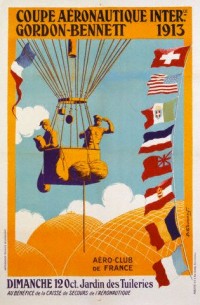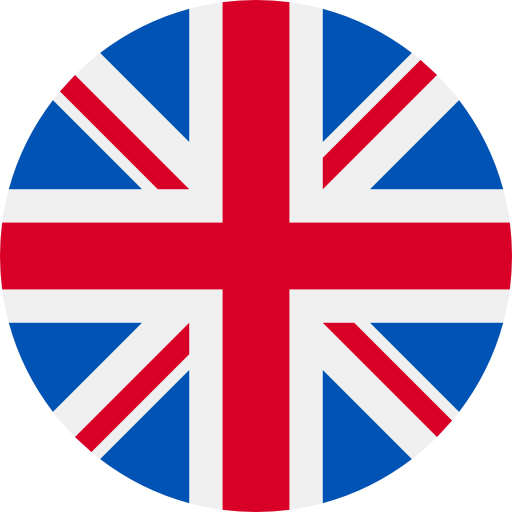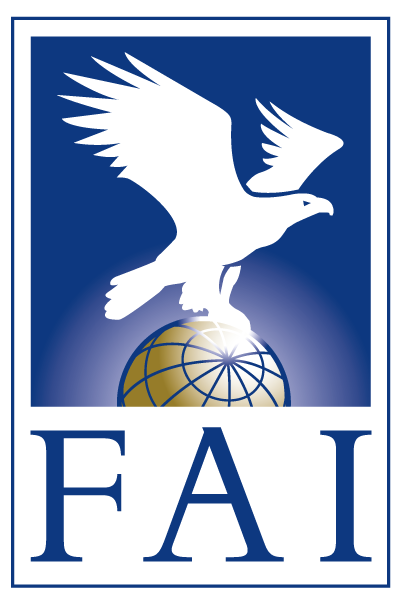8th Coupe Aéronautique Gordon Bennett
Paris, France, October 12, 1913

Results
| Rank | Pilots | Country | Score | Duration | Landing |
|---|---|---|---|---|---|
| 1 | Ralph H. Upson R.A.L. Preston |  USA USA | 618.00 km | 43:30:00 | Bampton, Bridlington, Devon (GBR) |
| 2 | Harry E. Honeywell J.H. Wade |  USA USA | 483.00 km | 29:35:00 | |
| 3 | Giovanni Pastini Benigni Tullio |  ITA ITA | 457.00 km | 32:35:00 | |
| 4 | Paul Armbruster H. Seiffert |  SUI SUI | 442.00 km | 30:00:00 | Bolazec (FRA) |
| 5 | Victor de Beauclair H. Biehly |  SUI SUI | 438.00 km | 29:55:00 | Kergavacu (FRA) |
| 6 | René Rumpelmayer Gustave Goldschmidt |  FRA FRA | 437.00 km | 00:00:00 | |
| 7 | Ernest Demuyter Albert Vléminckx |  BEL BEL | 435.00 km | 32:00:00 | St.Michel-en-Greve (FRA) |
| 8 | E. C. von Sigmundt ? |  AUT AUT | 425.00 km | 00:00:00 | |
| 9 | Alfred Leblanc Emile Dubonnet |  FRA FRA | 422.00 km | 00:00:00 | |
| 10 | Leon Gerard Eduard van Nuffel |  BEL BEL | 415.00 km | 00:00:00 | |
| 11 | Jean de Francia Welby-Jourdan | FRA/GBR | 377.00 km | 00:00:00 | |
| 12 | Agostini Guiseppe di Valle |  ITA ITA | 364.00 km | 00:00:00 | |
| 13 | Maurice Bienaime Jacques Schneider |  FRA FRA | 363.00 km | 00:00:00 | |
| 14 | John Dunville Corbet |  GBR GBR | 362.00 km | 00:00:00 | |
| 15 | Gustav von Pohl Paul Perlewitz |  GER GER | 347.00 km | 29:10:00 | |
| 16 | Hugo Kaulen Bruno Schmitz |  GER GER | 318.00 km | 28:00:00 | |
| 17 | F.W. Lehnert Kirsch |  AUT AUT | 289.00 km | 00:00:00 | |
| 18 | Hans Berliner Carl Richard Mann |  GER GER | 274.00 km | 25:10:00 | |
| 19 | John Watts Quisenberg |  USA USA | No Start | 00:00:00 | |
| 20 | Hans ? |  AUT AUT | No Start | 00:00:00 | |
| 21 | Palmarini ? |  SUI SUI | No Start | 00:00:00 |
Book Article
From the Book: Die Gordon Bennett Ballon Rennen
(The Gordon Bennett Races) by Ulrich Hohmann Sr
Start: Paris, Jardin des Tuileries, October 12th, afternoon
The circle closes, the launch of the Gordon Bennett Race returns to its birthplace from 1906. This had been achieved by Maurice Bienaime and Rene Rumpelmeyer with a flight from Stuttgart to the area of Moscow the year before. It was directed by fate, that this return happened exactly in the moment, when an interruption for a longer period stood at the front door. Nobody knew this of course, for times had become calmer. It still rumbled in the Balkans, even if the Osman empire had mostly renounced . their European possessions. But the Balkans were far away, seen from Paris much farther than from Stuttgart. Probably one can see in the fixing of the union of three (Germany, Austria and Italy) during the emperors exercises in Silesia a month ago, the beginning of a confrontation against France, England and Russia, which forced France to introduce the three years duty in military service.
High diplomacy, who did care about it in those days? It was much more than today the case of the leading heads, either monarchs or civil presidents of a republic. Much more a topic for discussion, at least for balloon pilots, was the explosion of the German navy airship L2 over Johannistal near Berlin, killing 24 people. Also new ways to travel in the air came up, and nobody really knew, how they would perform. But everything else, besides the normal catastrophes of nature, mine explosions, train accidents and ships sinking is quite normal.
The people among themselves understood each other, the sportsmen were friends. Of course, they fought for victory in a race, but before and after they shared experiences, discussed and helped each other. If someone would have told to a Bienaime or a Leblanc, that they have to hate an Eimermacher, Kaulen or Berliner or the other way round, because they were "iron foes", they would have refused without understanding.
Flying balloons was very attractive to the French people, more than half a million spectators were counted at the launch. They hoped for another French victory, but in vain. 18 pilots had come to Paris and everybody knew that they were "the best of the world". Honeywell, third the year before, was there, and also Bienaime and Rumpelmeyer, last years winners, flew separate this time. As "2nd man in the basket" a woman flew for the first time in a Gordon Bennett Race, Madame Gustave Goldschmidt. Emancipation was always a matter of course in ballooning. With Rene Rumpelmayer as pilot she had flown from Paris to the area of Charkov (Ukraine) on March 19th to 21st this year, putting the world distance record up to 2420 km. One had heard from Hugo Kaulen and Hans Berliner from Germany (and should soon hear much more), Armbruster, de Beauclair from Switzerland and young Belgian Demuyter were hot favourites for the victory. Only one would not be considered to be on one of the higher rankings: 25 year old Ralph H. Upson from the USA. Reason for this was among others, that he had become a pilot just one year before and, at least in the opinion of the other competitors and the journalists, could not have gathered enough experience and technical knowledge. Of course, he was a student of meteorology, or, as it was called in these days "the streaming of the air", but one still did not think very well about this science. Also his balloon was not in the best condition. A well know balloon manufacturer pointed some broken meshed in his net to him, Upson asked back: "Do you think, that the hole is big enough that the envelope could escape through it?"
There had also been a change in the selection of the pilots. Looking at the competitors lists of the first races shows, that a lot of officers, noblemen and industrialists took part in these flights. Ballooning was reserved to these circles of society in many countries. But now, thanks to Gordon Bennett, one could not only face adventures on these flights, but also gather fame for oneself and his home country. So it is quite understandable, that the national aero clubs took more influence in the selection of the competitors. They had to prove the adequate staying power and enough experience, the rest then came on its own.
Experience was quite different. Frank Lahm (1906) won in his 15th flight in a balloon, Edgar W. Mix (1909) had finished his instructions to become a balloon pilot just two years ago, so there was not too much experience. It looked quite better with Erbslöh, Theodor Schaeck, Alan R. Hawley and Hans Gericke. But all of them may not have cared much about tactical conditions and long preparations.
The more these races became known, the more fame came to the competitors and their countries and the more importance was put on selection of the balloon and the persons. One of the first, who added considering the influence of meteorological conditions to his planning, was Ernest Demuyter. The race in 1913 had contributed a lot to this, as he explains in his report:
Translation from Demuyter here
Meteorology in those days was in its childhood. Of course, the pilots got handed out the information from all meteorological stations round the world, and often the forecast for beginning rain, snowfall or storm was true. But there were no weather maps as we know today from the television every evening. There was also no weather briefing before launch. Everybody got his own information. What he then concluded and how he put it to practice was his own affair.
So they tried to save ballast, looked for a fast and adequate layer, put the track to a map and prolonged it, concluded then to fly a little higher or lower to catch some more kilometres over land before the sea put and end to the flight. One only risked to fly out to the sea, when the direction and power of the wind, seen by the heading till then, could guarantee a relatively safe arrival at the opposite coast. It was still well remembered what happened in 1908.
The morning after launch found the field close together about 200 kilometres south of Paris. Then the wind turned to the northwest, towards the Atlantic ocean. Now, according to the old way, one had to try to fly to the longest bulge of the land. That means, flying low, to the left, this was the direction for the Bretagne. Catching this peninsula of France allows to fly up to the town of Brest. American Honeywell managed this best, his most southerly heading brought him almost 500 km as the crow flys.
Italian Pastine tried it just the other way round and was also not without success. His most northerly heading brought him to Normandy almost up to the town of Cherbourg, at least also 450 kilometres far. All the others flew in between and therefore had to come back to earth at the bay of St. Malo. That would have been it, if not Mister Upson was absolutely confident in his science.
Today every balloon pilot knows (or should know it), that the wind turns right in a high pressure area and counter clockwise in a low. Today we know the gradient winds, floating almost parallel to the isobars. Mister Upson also knew this in his days. In the beginning, he did not care at all, flying more north or south, then, to the horror of the others, he crossed the coast, heading for his sure death, if he would not find a ship, fishing him out of the waves of the ocean.
He did not need the ship. He fell, caused by the cooling air above the water (and its influence on the temperature of the gas) from his former altitude, but got the balloon under control, overthrew, climbed much higher than before and headed now exactly north, towards the English coast between Exeter and Portsmouth. From there it went on in a wide bend, crossing the Bristol Channel, passing north of Birmingham, until the North Sea north of the little town Bampton, Devon, forced him to land after 43 1/2 hours of flight.
We had seen this before! 1906 American Frank P. Lahm made his victory not far from this place, but much more directly, not with this long detour over Southwest England. Upson told after his victory, that he had made a mistake in his calculations: He had not calculated the cooling above the water, without the fall he would have flown in a bend much more narrow above the Netherlands to Northwest Germany. But nobody believes this, especially with today's knowledge of his science. Such small circles are rarely permitted by a high over Scandinavia and a low west of England. And would this have been farther? – He got his victory with 618 kilometres, a victory of science over technical skill in a balloon, a victory of sober calculations over experience.
The end of the race caused another effect. Both Germans Hugo Kaulen and Hans Berliner had hoped for more success. They ended in the disappointing ranks 16 and 18. But hey did not rest, they knew about their skill and wanted to prove it to the world. Little later, they had the opportunity for it. On December 13th Hugo Kaulen went on a flight, bringing him the world record for duration with 87 hours. Hans Berliner waited another 2 month longer. On February 8th 1914 he flew east from Bitterfeld for 47 hours covering 3053 kilometres and landing at Perm in the Ural. That was the new world record in distance, first beaten on August 17th, 1978 with the first crossing of the Atlantic ocean. The history of this two flights is worth an extra book.
Later, after the war, Upson flew in two more Races, but could not repeat his success. The break of six years, following the 1913 race, also forced progress in meteorology for all, otherwise a war with poison gas would not have been possible. A lot of people would have loved to wait longer for these quick results.

